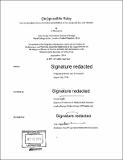| dc.contributor.advisor | Hiromi Ozaki. | en_US |
| dc.contributor.author | Hasegawa, Ai | en_US |
| dc.contributor.other | Program in Media Arts and Sciences (Massachusetts Institute of Technology) | en_US |
| dc.date.accessioned | 2017-03-20T19:40:17Z | |
| dc.date.available | 2017-03-20T19:40:17Z | |
| dc.date.issued | 2016 | en_US |
| dc.identifier.uri | http://hdl.handle.net/1721.1/107564 | |
| dc.description | Thesis: S.M., Massachusetts Institute of Technology, School of Architecture and Planning, Program in Media Arts and Sciences, 2016. | en_US |
| dc.description | "September 2016." Cataloged from PDF version of thesis. | en_US |
| dc.description | Includes bibliographical references. | en_US |
| dc.description.abstract | (lm)possible Baby is a speculative design project which aims to stimulate discussions about the social, cultural and ethical implications of emerging biotechnologies that could enable same-sex couples to have their own, genetically related children. Delivering a baby from same-sex parents is starting to not look like a sci-fi dream anymore recent developments in genetics and stem cell research, such as the achievements of scientists from Cambridge University in England and Israel's Weizmann Institute of Science 1 have made this dream much closer to reality. Jacob Hanna, the specialist leading the project's Israeli arm, said it may be possible to use the technique to create a baby in just two years. "It has already caused interest from gay groups because of the possibility of making egg and sperm cells from parents of the same sex," he said."2 Is creating a baby from same-sex parents the ethical thing to do? Who has the right to decide this, and how? This project aims to design and inspire debate about the bioethics of producing babies from same-sex couples. In this project, the DNA data of a lesbian couple was analyzed using 23andMe to simulate and visualize their potential children, and then we created a set of fictional, "what if' future family photos using this information to produce a hardcover album which was presented to the couple as a gift. To achieve more public outreach, we worked with the Japanese national television service, NHK, to create a 30-minute documentary film following the whole process, which aired in October 2015. | en_US |
| dc.description.statementofresponsibility | by Ai Hasegawa. | en_US |
| dc.format.extent | 55 pages | en_US |
| dc.language.iso | eng | en_US |
| dc.publisher | Massachusetts Institute of Technology | en_US |
| dc.rights | MIT theses are protected by copyright. They may be viewed, downloaded, or printed from this source but further reproduction or distribution in any format is prohibited without written permission. | en_US |
| dc.rights.uri | http://dspace.mit.edu/handle/1721.1/7582 | en_US |
| dc.subject | Program in Media Arts and Sciences () | en_US |
| dc.title | (Im)possible baby : how to stimulate discussions about possibilities of two-mum and two-dad children | en_US |
| dc.title.alternative | Impossible baby : how to stimulate discussions about possibilities of two-mum and two-dad children | en_US |
| dc.type | Thesis | en_US |
| dc.description.degree | S.M. | en_US |
| dc.contributor.department | Program in Media Arts and Sciences (Massachusetts Institute of Technology) | en_US |
| dc.identifier.oclc | 974641327 | en_US |
